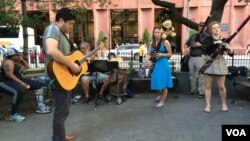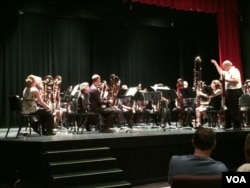Bassoons have been called the clown of the orchestra, an ill wind, and even a burping bedpost.
It seems the one-and-a-quarter meter tall wooden tubes get no respect. Except, perhaps, at the annual meeting of the IDRS - the International Double Reed Society. Hundreds of professional, amateur and student bassoonists joined their brethren - oboe, English horn and contra-bassoon players - at New York University for their 43rd annual convention.
Most people don't even know what a bassoon is, says IDRS president - and bassoonist - Keith Sweger.
“Well, first they ask what I play and I say bassoon, and they usually describe an oboe. so, that is typical," he said. "But I do try to say, oh, well, [it represents] the grandfather from Peter and the Wolf.”
This family of musical instruments gets that distinctive sound from its reed, which is made from two wafer-thin pieces of bamboo cane bound together. When the player blows into the reed, the two pieces vibrate together, just like human vocal cords do.
Sweger says these instruments are at home in any genre of music.
“You find double reeds in pop music, you find them in jazz, you find them all over the place.. and a lot of times sprinkled in, in such a way that people don’t even recognize that they're there, which is wonderful," he said. "But again traditionally, we expect to see these instruments and hear them in orchestras, in chamber groups, in bands, wind ensembles.”
There are generally just one or two bassoons in a symphony orchestra, compared with a dozen or more violins or cellos. Aiden Brawn, a college student from New Jersey, says their common interest bonds the players, and creates a sense of community that doesn’t exist the other instruments.
"I think you …..have to be a little eccentric to play the bassoon, I think that's what brings us all together,” he said.
There were 137 events crowded into the five day conference.
Participants enjoyed concerts, master classes and workshops, including one on a technique called circular breathing, led by Stephen Moschner from Melborne, Australia. It involves blowing air out of your mouth while inhaling through your nose. Moschner brags he can hold a note for 15 or 20 seconds without taking an audible breath.
The annual gathering creates a rare opportunity for masses of instruments to perform together, like the 22 contrabassoonists of the Contra Band, who gave a new dimension to the Richard Strauss tone poem, Thus Spake Zarathrusa, perhaps better known as the theme from 2001: A Space Odyssey.
The instrumentalists also showed their whimsical side, with a flash mob performance, taking people in New York's Washington Square Park by surprise with a rendition of New York, New York, complete with choreography and a drag-queen singer.
There are opportunities for everyone to make music at the International Double Reed Society conference. And they'll do it all again next year, at the 2015 conference in Tokyo, Japan.










